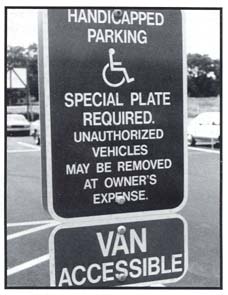

With the passage of the 1968 Architectural Barriers Act and the 1973 Rehabilitaition Act, a great deal was accomplished to create barrier-free environments and accessible routes. However, users of wheelchairs continue to experience difficulties when traveling, and those who use van transportiation as opposed to a car have a much more arduous time finding a parking space and are at risk of being stranded.
It was not until the passage of the Americans with Disabilities Act (ADA) in 1990, and the Department of Justice notice of proposed rulemaking for ADA (February 22, 1991), that the Department received numerous comments and concerns regarding parking spaces by users of wheelchairs who utilize vans with lifts. In response to these comments and the increasing use of vans with side mounted lifts, the Architectural and Transportation Barriers Compliance Board (ATBCB) made revision in specifications for parking spaces and adjacent access aisles (Federal Register, July 26, 1991).
According to the ADA, the typical accessible space for a car with a special plate or placard is at least eight feet wide with an adjacent aisle not less than five feet wide. However, a five-foot wide aisle is inadequate and does not provide ample space to park a van and exi from a side-mounted lift.
The ATBCB requires that a van accessible parking space provide an eight-foot wide access aisle which is just big enough to maneuver and exit from a side-mounted lift. In addition, a van accessible space must be marked by a sign showing not only the accessibility symbol, but an additional sign to alert van users to the presence of an adequate space. It should be noted that van accessible parking spaces can be used by either vans or cars showing the proper plate or placard.
The regulations found in the ADA do not guarantee parking accessibility to those who use vans for transportation. Stories are often told by users of wheelchairs about: (a) towns that have not created van accessible spaces, (b) individuals who park in the adjacent van access aisle, thus rendering the lift of the van inoperable, and (c) drivers of vans who leave the side-mounted lift down while parked so the adjacent access aisle cannot be used by cars.
To assist with the implementation and enforcement of the ADA parking regulations related to vans, local governments need to be more active. To address this need, the Commonwealth of Massachusetts recently passed a law requesting city and town governments to establish commissions on behalf of persons with disabilities. Commissions are to research local problems or issues confronted by those with disabilities in their community and advice or assist municipal officials to ensure compliance with state and federal laws and regulations.
Moreover, some towns around the country who report frustration with the abuse of parking spaces are initiating volunteer parking enforcement programs. In the town of Natick, Massachusetts, for example, three volunteers appointed by the Police Department and the local Commission on the Disabled use instant cameras to document violations. The Natck Police will then inspect the photograph and volunteer affidavit and, if appropriate, mail a copy of the two documents along with a parking ticket to the violator.
Another concern for those who use vans is the problem of increased issuance of plates and placards by state registries of motor vehicles. For example, the number of disability permits in Virginia rose 60% between 1990 and 1994 (Fairfax Journal, June 5, 1995); while the number issued by the Massachusetts Registry of Motor Vehicles jumped 500% between 1991 and 1995 (The Boston Sunday Globe, January 29, 1995).
City and town officials face a dilemma. They can limit the number of accessible parking spaces to that required by the ADA, thus forcing persons with disabilities to compete for available spaces; or increase the number of parking spaces for those with disabilities, but then risk facing angry local citizens' complaints about the loss of parking for non-disabled individuals.
The ADA is one more avenue for removing barriers, but it is not perfect. The law has certainly heightened awareness of the needs users of wheelchairs have who utilize vans with lifts. The strategy for meeting these needs is complex, dynamic, and plays out at the local level. It is up to each citizen to be more proactive by helping to shape local policies and influence events.